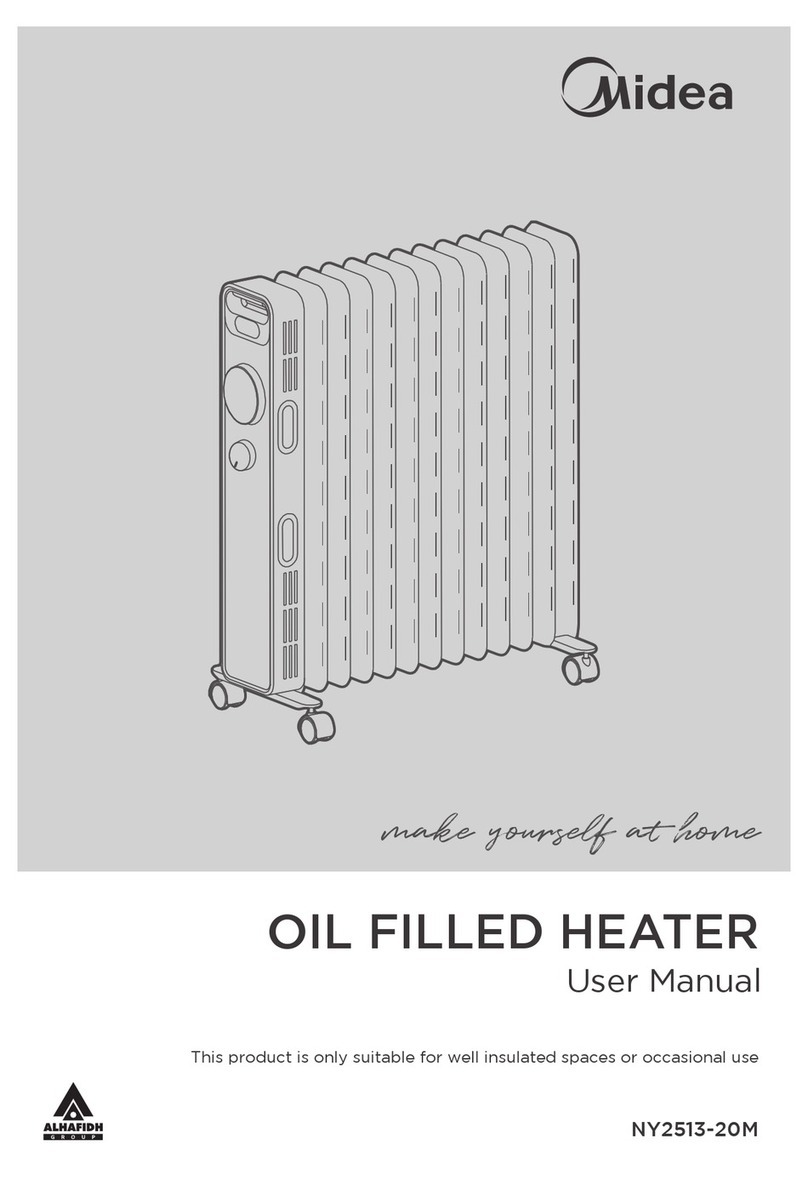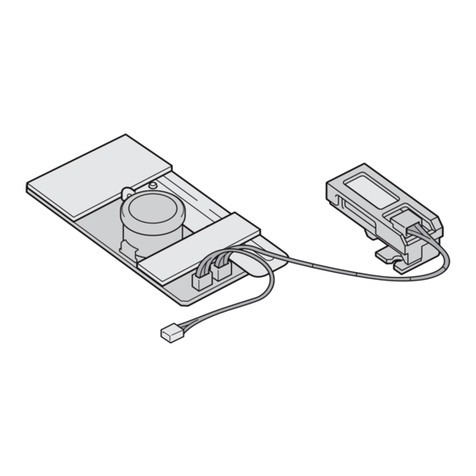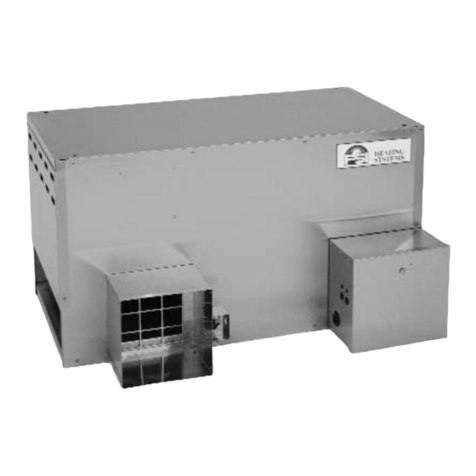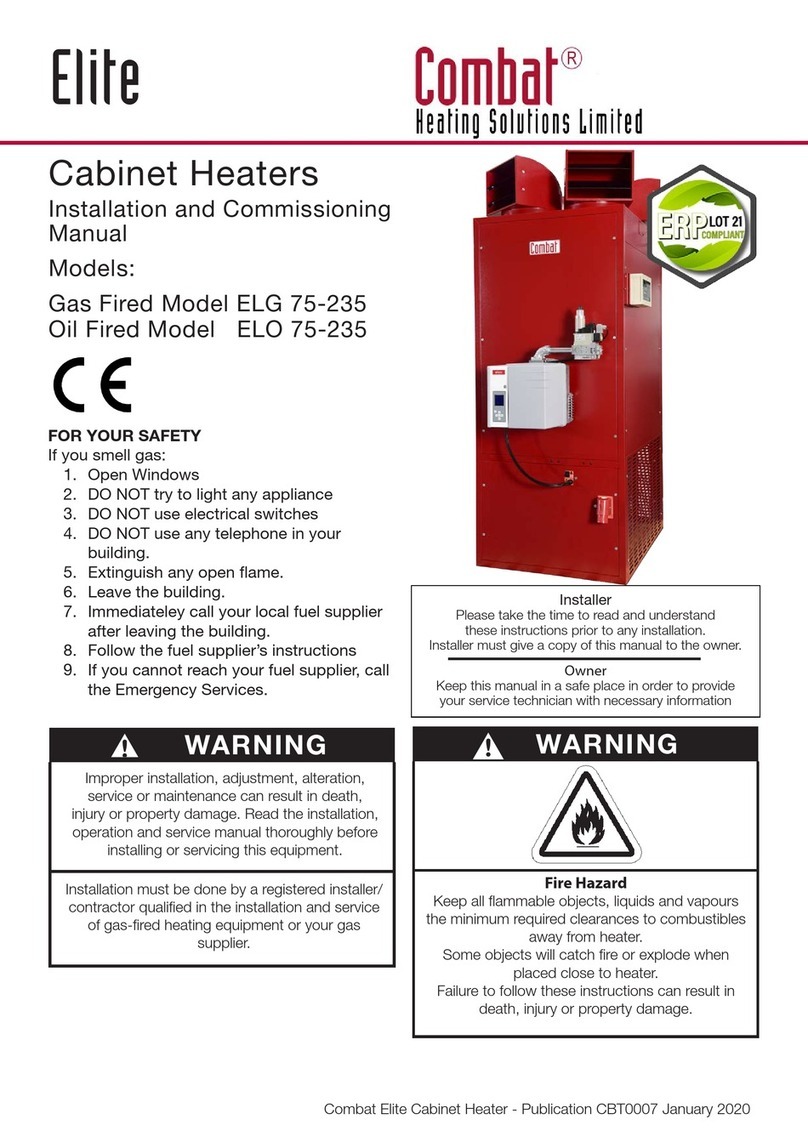dB AM Series Guide

Series AM Fan Convectors
Installation, Operation & Maintenance Instructions
Dunham-Bush Ltd, Downley Road, Havant, Hants PO9 2JD
Document Ref:
023 9247 7700
info@dunham-bush.co.uk
121-000-001-D
UK:www.dunham-bush.co.uk
Global:www.dunham-bush.com
July 2021
1
INSTALLER: Please leave these instructions, heater wiring diagram & access panel keys with the user.
INTRODUCTION
This booklet provides guidance to identify, handle,
install, commission, operate and maintain
Dunham-Bush Series AM fan convectors. The
instructions apply to the standard range of 22
models shown on page 2. Please study the
instructions carefully before commencing any
installation work.
IDENTIFICATION
The fan convector serial number, model description,
figure number (size) are displayed on a label found
on the inside of the heater access panel. If specified,
a stencil reference may also be marked on the
heater on-site identification.
DESCRIPTION
Each Series AM fan convector comprises a sheet
steel casing with a lockable access panel, fan/motor
assemblies, air filter and hot water heating coil.
Single phase electric elements can be fitted instead
of a hot water coil. Heaters can be supplied for one
or two speed fan operation ; single speed units are
pre-set to low, medium or high speed, and two
speed units are pre-set to low/medium, low/high or
medium/high speeds, as ordered.
Fan control is by means of switches and/or
thermostats, listed in Accessories.
Diagram 1: Series AM Model 13 Figure 04 with left hand coil connections - *items are optional accessories

2
Diagram 2: Range of standard models and accessories

3
RANGE
The standard range comprises 22 standard models,
in 4 categories - floor standing, ducted floor
standing, wall mounted and ceiling mounted. Refer
to Diagram 2 on page 2 for model identification.
All models are available in seven sizes (figure
numbers), with the nominal output indicated by the
figure number.
Size
Nominal output
(kW)
Casing width
(mm)
Fig 03
2.6
695
Fig 04
4.7
895
Fig 06
6.0
895
Fig 08
8.2
1195
Fig 10
9.4
1195
Fig 12
11.4
1495
Fig 15
12.7
1495
Table 1: Nominal outputs and sizes
CONTROLS
Fan motors
Conventional synchronous AC motors or energy
efficient EC motors can be provided. EC motors are
available as one of two options:-
ECS - speed control by an external 2-10VDC signal
ECM - speed control by fitted speed interface
Air thermostats
Air thermostats can be provided to automatically
switch the heater on/off and to change the fan
speed/heat output, in response to a fall or rise in
ambient air temperature. Thermostats can be fitted or
remote as follows :-
Fitted air thermostats - Models 13, 15, 17, 20, 21, 23
and 25 only.
Capillary thermostats, or room thermostats with an
accelerator heater, can be fitted for on/off and speed
change.
Diagram 3: Fitted on/off & high/low thermostats
Remote thermostats - All models
Standard or tamper resistant room thermostats with
an accelerator heater, can be provided for on/off and
speed change.
Low temperature cut-out (LTC) thermostat
A low temperature cut-out thermostat may be
provided to operate the heater when hot water is
supplied to the coil. This will automatically stop the
heater at the end of a normal operating period e.g.
when the boiler plant shuts down:-
Type 1 (fixed) make circuit at 50°C±3K
break circuit 38°C±3K
Type 2 (adjustable) range 30 - 90°C
Switches
Fitted switches (external, or internal) or remote
switches (flush or surface wall mounting) can be
provided to switch the heater on/off, change fan
speed and/or override any thermostats.
Diagram 4: Fitted man/off/auto & high/low switches
The man/off/auto switch allows the fans to circulate
room air when the boiler plant is shutdown during the
summer.
A FAI/recirc switch can also be provided to open or
close fresh air inlet (FAI) dampers (models 19, 22,
53 and 88 with optional motorised damper).
Switch types are:
1 on/off
2 high/off/low
3 manual/off/auto
4 manual/off/auto and high/low
5 FAI/recirc
6 FAI/recirculation and high/off/low
7 FAI/recirculation and manual/off/auto
8 FAI/recirculation, manual/off/auto and
high/low
Special controls
If specified, the heater may incorporate special
controls such as relays, thermal controls etc.
These will be shown on the wiring diagram supplied
with each heater.

4
ACCESSORIES
Electric heating (single stage up to 6kW) on sizes
Fig 03, Fig 04 and Fig 06 on all models. Heaters are
single speed and may be supplied with
programmable thermostat/timeclock.
Manual damper for fresh air inlet or recirculating air
on models 19, 22, 53 and 88.
Motorised damper with 230V actuator for fresh air
inlet or recirculating air on models 19, 22, 53 and 88.
(Use with FAI /recirc. switch)
100mm, 150mm or 200mm high plinth on floor
mounted models
Remote pencil proof grille and fixing frame available
on models 15, 16, 17, 41, 21, 23 and 92.
Isolating valves fitted on flow and return coil
connections on most heaters as space permits, or
supplied loose for fitting to pipework.
PREPARATION
Handling
The purchaser is responsible for off-loading. Heaters
are individually packed and two/three persons can
usually handle the heaviest heater. If a significant
quantity is delivered, they may be palletised and
shrink-wrapped, so a fork-lift or similar will be
required for lifting. Heater must not be dropped or
suffer impact in any circumstances.
Storage
Heaters should be stored in clean, dry conditions.
Any packaging should not be removed until the
heater is required for installation and should only be
removed if damage is suspected at delivery
.
Fixing & Connections
Make proper provision for fixings. The structure to
which heaters are to be fixed must be fit for purpose
and capable of accepting plugs and screws, anchor
bolts or drop rods. Floor models require a level base.
Floor and wall models require a sound flat wall
surface. Heater casings are supplied with knockouts
for pipework and conduit entry.
Piping and electrical conduit should, as far as
possible, have been completed and any wall
apertures for loose grilles and ductwork should be
fully prepared.
WARNING:
Some internal components may have sharp edges. Protective gloves should be worn.
INSTALLATION
General
1.
Check the identity of the heater marked on
the outside of the carton. The carton can be
saved to protect the heater from damage by
other trades after installation.
2. Unlock and remove the access panel with the
key provided with the heater. On ceiling
models, safety screws retain the access panel
in a hinged position.
3. Re-check the identity of the heater, from the
serial number on the nameplate.
Diagram 5 : Mains inlet plug and fuse holder
4. The inner cover, fans/motors pipework cover
plate, filter and grilles can all be removed to
provide better access when making pipework
connections and to allow easier lifting of wall
and ceiling models. (See Diagram 6)
5. Disengage the line connector to disconnect
the wiring harness to the fan platform. On
ceiling models, remove the platform retaining
brackets before removing the platform.
6. Remove the casing knockouts,to suit pipework
and conduit entry
Diagram 6 : Fan and inner side plate removed

5
Floor models 13, 15, 16, 17, 19, 25, 37, 41 and 88
1. Models 15 & 41 - see Diagram 12 on page 9.
Model 17 - see Diagram 13 on page 10.
Models 19 & 88 - see Diagram 14 on page 11.
2. Note the position of the Ø5 fixing holes in the
heater backplate; mark-out, drill and plug.
3. Position and fix the heater ; ensure that the
foam strip around inlet and outlet apertures
on models 15, 16, 17, 19, 41 and 88 provides
an adequate seal.
4. If specified, fit loose grilles and fixing frames
into wall apertures, models 15, 16, 17 and 41,
as detailed on page 14. (If applicable, fit
external weatherproof louvres for models 19
and 88).
5. Pipe up as detail in
Pipework Connections
on
page 6.
6. Wire up as detailed in
Electrical Connections
and Controls
on page 7.
7. If supplied, fit the adjustable (type 2) low
temperature cut-out thermostat to the
LTHW flow pipe.
8. After filling the system, check for leaks (see
Commissioning
on page 7).
9. Replace all components previously removed.
10. Where appropriate, cut the back out of the
carton and tape into position over the heater.
11. When ordered with the heater, a plinth will be
fitted at our works ; pipework can enter the
plinth through knockouts provided
(see Diagram 18 on page 14).
Fixed duct models 20, 21, 22 and 60
1. Model 21 - see Diagram 15 on page 12.
Model 22 - see Diagram 14 on page 11.
2
.
In addition to the main access panel, unlock
the duct access panel, lift and remove.
3. Note the positions of the Ø5 fixing holes in the
heater backplate; mark-out, drill and plug.
4. Position and fix the heater ; ensure that
the foam strip around apertures on models 21
and 22 provides an adequate seal.
5. If specified, fit loose grilles and fixing frames
into wall apertures, model 21, as detailed on
page 14. (If applicable, fit external
weatherproof louvres for model 22).
6. Connect pipework to the coil as described in
Pipework Connections
on page 6.
7. Wire up as detailed in
Electrical Connections
and Controls
on page 7.
8. If supplied, fit the adjustable (type 2) low
temperature cut-out thermostat to the LTHW
flow pipe.
9. After filling the system, check for leaks (see
Commissioning
on page 7).
10. Replace all components previously removed.
11. Where appropriate, cut the back out of the
carton and tape into position over the heater.
12. When ordered with the heater, a plinth will be
fitted at our works ; pipework can enter the
plinth through knockouts provided
(see Diagram 18 on page 14).
Adjustable duct models 23 and 92
1. Models 23 & 92 - see Diagram 16 on page 13.
2. In addition to the main access panel, the
adjustable top duct and duct access panel can
be removed.
3. Remove the main access panel and note the
positions of the Ø5 fixing holes in the heater
backplate; mark-out, drill and plug.
4. Position and fix the heater into position ;
ensure that the foam strip around apertures
provides an adequate seal, before securing
the heater in position with suitable fixings,
through the holes in the backplate.
5. Raise the adjustable duct to suit the position
of the wall aperture, previously prepared.
6. Fix the adjustable duct into position, through
the holes in the duct side flanges, ensuring
there is a good seal between the heater and
wall.
7. If specified, fit loose grilles and fixing frames
into wall apertures, as detailed on page 11.
8. Connect pipework to the coil as described in
Pipework Connections
on page 6.
9. Wire up as detailed in
Electrical Connections
and Controls
on page 7.
10. If supplied, fit the adjustable (type 2) low
temperature cut-out thermostat to the LTHW
flow pipe.
11. After filling the system, check for leaks (see
Commissioning
on page 7).
12. Replace all components previously removed.
13. Where appropriate, cut the back out of the
carton and tape into position over the heater.
14. When ordered with the heater, a plinth will be
fitted at our works ; pipework can enter the
plinth through knockouts provided.
(see Diagram 18 on page 12).

6
Ceiling/wall models 28, 30, 31, 34, 38, 52 and 53
1. Loosen the M8 screws which attach the
suspension brackets to the heater casing and
remove the brackets.
2. Position and fix the suspension brackets to
the ceiling or wall; see Diagram 19 on page
15.
3. Lift the heater into position and secure the
heater to the suspension brackets by the four
M8 screws. (If applicable, fit external
weatherproof louvres for model 53).
4. Connect pipework to the coil as described in
Pipework Connections
below.
5. Wire up as detailed in
Electrical Connections
and Controls
on page 7.
6. If supplied, fit the adjustable (type 2) low
temperature cut-out thermostat to the LTHW
flow pipe.
7. After filling the system, check for leaks (see
Commissioning
on page 7).
8. Replace all components previously removed.
9. Where appropriate, cut the back out of the
carton and tape into position over the heater.
Pipework connections
WA1, WA2 & WA3 coils
- DN20 (3/4”BSP) female parallel
WA4 coils
- 22mm plain copper tails
Local isolating and regulating valves are
recommended. Observe the correct flow and return
positions, to ensure the rated heat output, see
Diagram 7. Fill the system and check for leaks.
Coils fitted
with :-
Cold test
pressure (bar g)
Working pressure
(bar g)
Type M air
vent
10.5
7.0
Type A air
vent
9.0
7.0
Table 2: Site test and working pressures
Diagram 7: Hot water coil connections, as viewed on the header/connection end of the coil.
NOTE: For correct operation, the back face of the Type 2 adjustable low temperature cut-off
thermostat needs to be in contact with a straight length of pipe approx. 100mm.
Avant Garde & LST Heaters
Avant –Garde and LST heaters are supplied
with controls valves which automatically shut
off the water flow when the fan is not
running.
Depending on the model and coil
arrangement supplied, the valves may be
supplied loose with special pipework for
fitting on site (see Diagram 8).
Flow and return connections must be
connected as shown in Diagram 8. The
diagram shows 4 port valve arrangement (2
port valve similar), with the LTC position
indicated.
Diagram 8: Control valve and LTC fitting locations

7
Electrical Connections and Controls
1. Connect a 230v/1ph/50Hz supply to the IEC
mains inlet connector. (see Diagram 5 on
page 4).
2. Fix any remote accessories-switches or
thermostats in the appropriate locations and
connected to the 12 way terminal block, as
shown on the wiring diagram supplied with the
unit (N.B. the 12 way terminal block is fitted
only when remote accessories are ordered
and shown on our wiring diagram).When
supplied the terminal block is located behind
the plate on which the mains inlet connector is
fitted.
Loose Grille and Fixing frame
1. Check dimensions and position of the grille
and frame in relation to the heater.
2. Prepare an opening to accept the frame.
3. Fit spire captive nuts into the slots in each
corner of the frame, and fix to the opening with
appropriate fixings (not supplied).
4. Fit the grille to the frame, aligning the holes in
the grille with the spire nuts in the frame and
fix using the black self-tapping screws
provided.
5. An alternative fixing can be to omit the fixing
frame and screw through the grille flanges
directly onto a suitable surround.
COMMISSIONING
General
1. Purge air from the coil using the manual or
automatic air vent, or through the mains
above the coil if applicable. Balance the
water flow rate through the system to
accepted practice.
2. If LTC thermostat fitted, the fans will run
when water in the flow pipe reaches the
required temperature. For a type 1 (fixed
setting) 54°C ± 3K or for type 2 (adjustable
setting) 30-90°C. A setting of 20K less than
the mean water temperature is
recommended). In the absence of hot
water, a temporary link can be used.
3. If fitted, adjust air thermostats to the
specified temperatures. If no settings are
specified, typical settings are:
a) on/off thermostat - set to 20°C
b) high/low thermostat - set to 16°C.
4. Check the operation of all thermostats by
varying their settings to achieve the desired
effect on the fan.
5. If switches are fitted check for satisfactory
operation.
6. A manual/off/auto switch will bypass all
thermostats when in the manual position.
This allows the fan to circulate room air
when no hot water is present.
7. If a manual damper is fitted, check the
operation of the damper lever.
8. If a motorised damper is fitted, check for
satisfactory operation. Damper control is
provided by a FAI/recirc. switch, if fitted.
9. Leave this document and all wiring
diagrams with the end user.

8
Fan Speed Adjustment (EC Motors)
1. Heaters fitted with EC motors are available
as one of two standard options:-
ECS - variable fan speed with speed control
by an external 2-10VDC signal (e.g.
from BMS)
ECM - single or dual fan speed with speed
control using switches or thermostats
via a fitted speed interface.
2. In the unlikely event that fan speeds require
adjustment, refer to the wiring diagram
supplied with the heater. Contact Dunham-
Bush for guidance on adjusting fan speeds
and selecting appropriate DC signal voltages.
3. The ECM speed controller is located
underneath the fan/motor platform and
comprises electronic controls with inputs
from thermostats and/or switches and a
single analogue 2-12VDC output signal to
the motor(s).
4. Refer to Diagram 9; three fan speeds are
available. Single speed heaters will use one
speed and dual speed heaters will use two
speeds, which can be varied by adjusting the
appropriate potentiometers; signal voltage can
be measured across 0V and CTRL terminals.
5. Avoid setting fan speeds too low:-
a) low fan speeds can cause stratification of
heated air within the room, reducing
effective comfort
b) low fan speeds with electric heating can
cause false tripping of high-temperature
safety cut-outs in the heater.
6. All connections to the EC fan controller shown
in Diagram 9 are safe low voltage of 10VDC
or less.
Diagram 9: Fan speed interface with 3 speeds
(ECM fan motor option only)
Size
Low speed
Medium speed
High speed
Fan
voltage
(VDC)
Airflow
(l/s)
Running
current
(A)
SFP
(W/l/s)
Fan
voltage
(VDC)
Airflow
(l/s)
Running
current
(A)
SFP
(W/l/s)
Fan
voltage
(VDC)
Airflow
(l/s)
Running
current
(A)
SFP
(W/l/s)
Fig 3
3.4
50
0.08
0.16
4.6
75
0.14
0.19
6.2
110
0.26
0.26
Fig 4
3.5
75
0.10
0.13
5.5
110
0.20
0.20
7.5
150
0.40
0.30
Fig 6
5.2
105
0.18
0.19
7.5
150
0.40
0.30
8.8
175
0.54
0.38
Fig 8
3.4
130
0.16
0.12
5.8
220
0.40
0.21
7.1
275
0.64
0.27
Fig 10
5.4
205
0.35
0.19
7.0
270
0.64
0.27
7.7
290
0.77
0.31
Fig 12
4.4
210
0.30
0.16
5.8
280
0.54
0.22
7.0
350
0.82
0.27
Fig 15
5.8
280
0.54
0.22
6.7
330
0.60
0.21
7.0
350
0.82
0.27
Table 3: Electrical data for EC motors (ECM motor options only; data for ECS motor option will vary)
Optional Panel Lock Indicators
Colour indicators show whether an access panel is
locked or unlocked. The lock position is shown
through the 10mm viewing window next to the lock;
green indicates the panel is safely locked and
cannot be removed or fall out; red indicates that the
access panel is unlocked.
Lock indicators can be retro-fitted to all Series AM
models by replacing the standard access panel with
a new one which includes the lock indicators. For
panel lock indicators, refer to Dunham-Bush, stating
part numbers reference 21-253-208. Price and
delivery upon application.
Diagram 10: Lock indicator green –panel locked Diagram 11: Lock indicator red –panel unlocked

9
Diagram 12: Typical installation detail for Models 15 and 41

10
Diagram 13: Typical installation detail for model 17

11
Diagram 14: Typical installation detail for models 19, 22, 53 and 88.

12
Diagram 15: Typical installation detail for model 21

13
Diagram 16: Typical installation detail for models 23 and 92

14
Diagram 17: Fixing detail for loose grille and fixing frame
Diagram 18: Fixing detail for plinth

15
Diagram 19: Fixing detail for suspension brackets (wall and ceiling mounted units)

16
CLEANING AND MAINTENANCE
WARNING:
Prior to undertaking any cleaning or maintenance, ensure that all electrical supplies are disconnected from
the heater via local isolators. Some internal components may have sharp edges. Protective gloves should be
worn.
Inspection
Frequency of cleaning and inspection depend
upon the operating conditions. Initially, it is
suggested that the air filter is inspected after 6-8
weeks and cleaned as required at regular
intervals. Cleaning the air filter ensures that the
heater delivers the required air flow rate and heat
output. The heater should not be operated without
a filter, since the heater coil fins will become
clogged with fluff and dust particles, resulting in
reduced performance.
Filter access and removal
To gain access to the air filter, unlock and remove
the access panel with the special key provided.
Floor, wall and duct models, pull the access panel
at the top and lift clear. Ceiling models, hinge the
access panel down and allow it to hang from the
safety screws (note: access panel can be
removed by removing the safety screws).
Cleaning
1. Air filters can be cleaned by tapping out
excess dust and washing in warm water
(up to 40°C), using detergent if necessary.
The filter must be rinsed and allow to dry
naturally before replacing. Do not use a
vacuum cleaner, as it can damage the filter
media. Filters should be replaced after
approximately 20 washes.
2. Because the air filter retains most of the
dusty particles, it will only be necessary to
clean the fan/motor assemblies and heater
coil annually. An industrial vacuum cleaner
can used to clean the inside of the heater,
in particular the heater coil(or electric
element) and fans, with the air being
sucked through the heater coil in the
opposite direction to normal air flow. All
accessible surfaces can be wiped with a
dry cloth.
Maintenance
1.
Coil
- Purge any air from the coil using the
manual air vent (using a suitable key) or by
turning the knurled thumbwheel on the
automatic air vent if fitted. Automatic air
vents have a built-in check valve which
allows the head to be removed without
draining the system.
2.
Motors
- The fan motor has ‘sealed for life’
bearings which do not require any
maintenance, other than visual inspection.
3.
Fuse
- The mains inlet connector on the
electrical connections box incorporates a
2A anti-surge fuse. A spare fuse is
supplied in a slide out fuse holder next to
the socket.
4.
Controls
- see accessories . A wiring
diagram is supplied with each heater.
Further copies are available on request,
please quote the serial number from the
nameplate, located inside the heater.
Please note :
1. If fitted, the LTC thermostat will switch
power to the fan only when the thermostat
reaches the required temperature. For a
type 1 (fixed setting) approx. 50°C ± 3K or
for type 2 (adjustable setting) 30-90°C (the
recommended setting is 20K less than the
mean water temperature)
2. If air thermostats are fitted (either to the
heater or remote mounted on a wall),
adjust to the specified temperatures.
Typical settings are:
a) on/off thermostat - set to 20°C
b) high/low thermostat - set to 16°C.
3. If fitted or remote switches are being used,
check that they operate correctly. Note : if
manual/off/auto switch is provided, all
thermostats are by-passed in the manual
position, which allows the fans to circulate
room air when the boiler plant is shutdown.
SPARES/SERVICE
PLEASE WRITE THE DETAILS OF THE UNIT HERE.
These details will be required when ordering spares for you Dunham-Bush Series AM Fan Convector.
UNIT TYPE AND MODEL INFORMATION
SERIAL NUMBER
DATE OF INSTALLATION
Spare parts/service –Please contact our office, contact information shown below.
Manufacturer reserves the right to change any product specification without notice.
Table of contents
Popular Heater manuals by other brands

Brant Radiant Heaters
Brant Radiant Heaters BAH Series Installation operation & maintenance
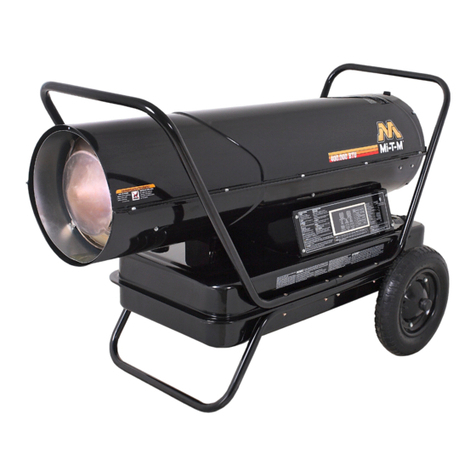
Mi-T-M
Mi-T-M MH-0400-0M10 Operator's manual
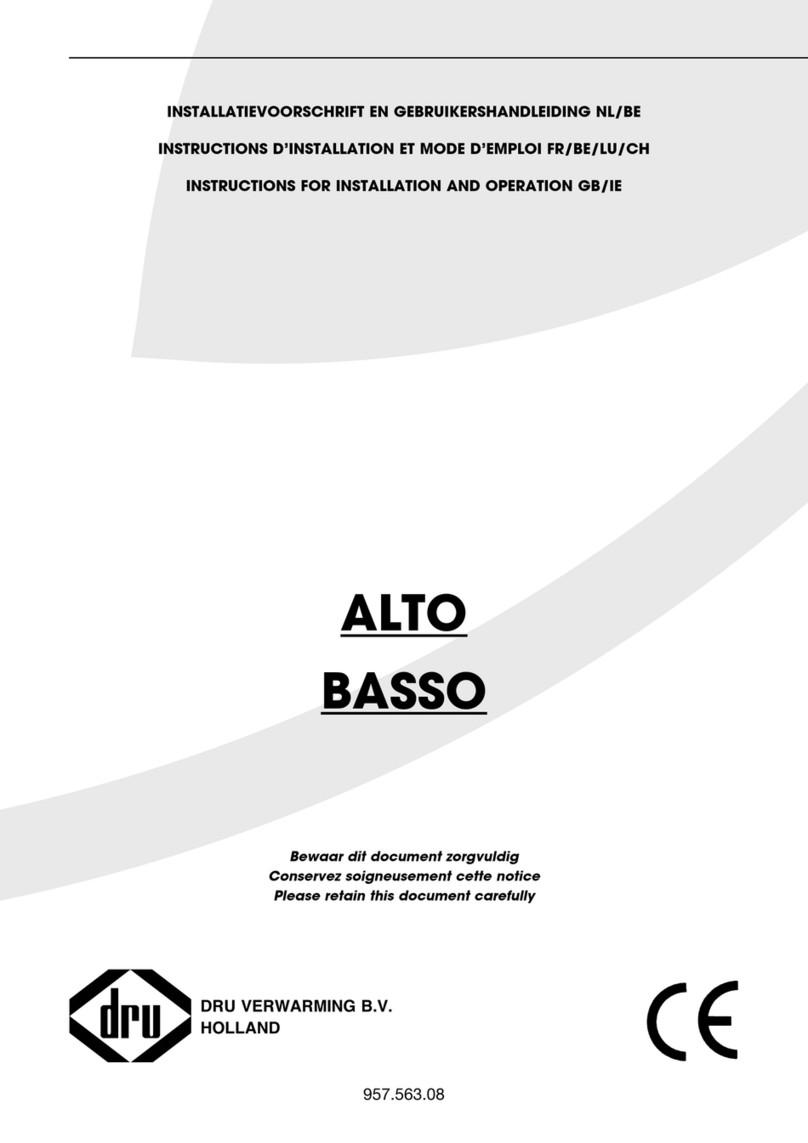
Dru
Dru ALTO Instructions for installation and operation

Reznor
Reznor OH Installation & operation manual

Volvo
Volvo 30756864 installation instructions
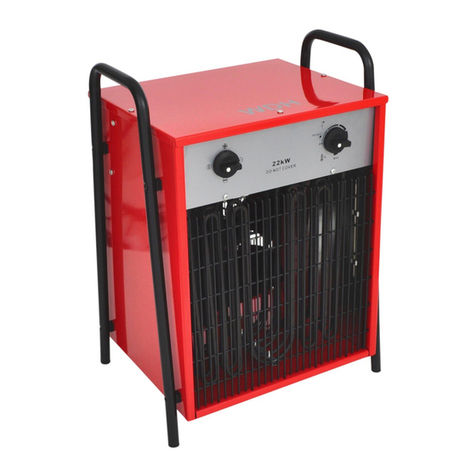
Aktobis
Aktobis WDH-IFH22 manual
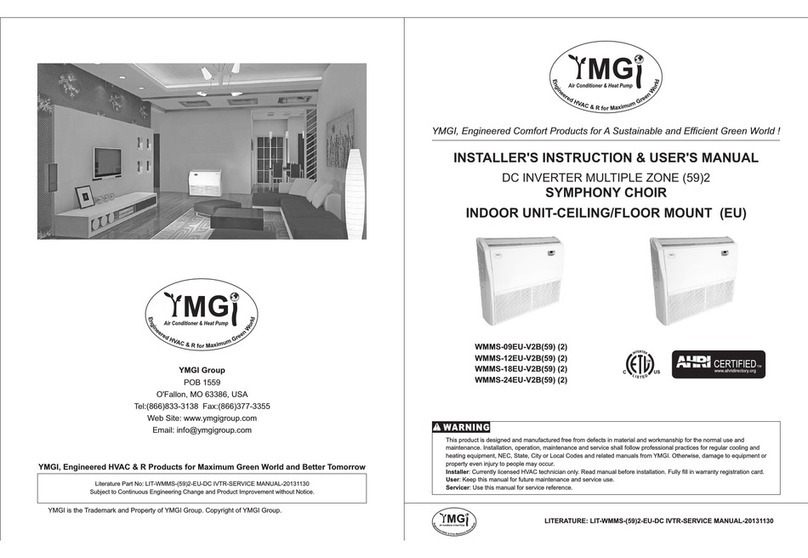
YMGI
YMGI WMMS-09EU-V2B Installer's instruction & user's manual

Rointe
Rointe Symga instruction manual
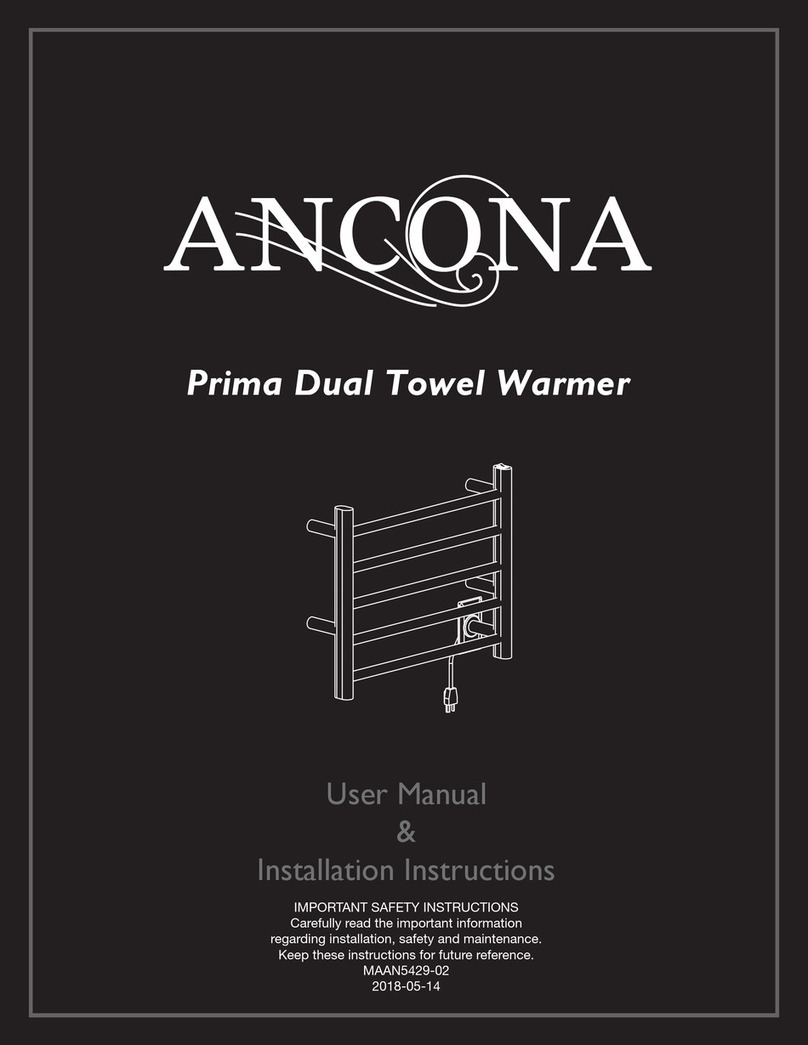
Ancona
Ancona Prima Dual User's manual & installation instructions

Detroit Radiant Products
Detroit Radiant Products AG2 series Insert manual
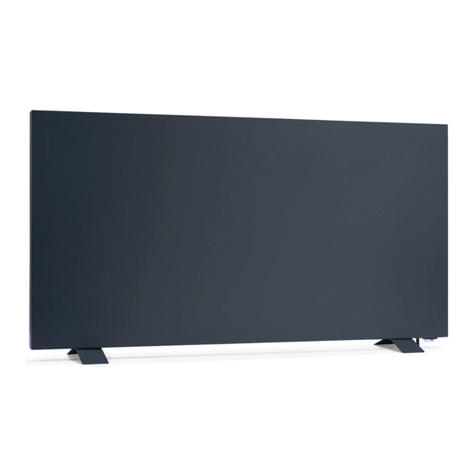
Klarstein
Klarstein Taal Smart manual
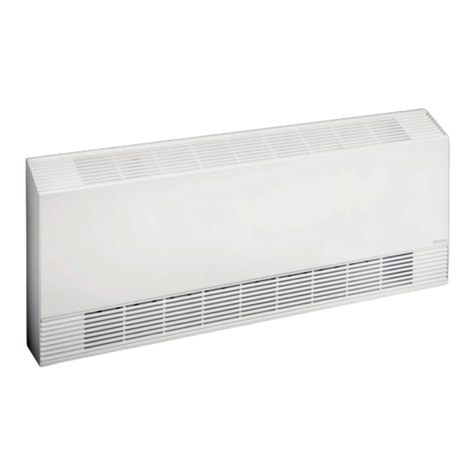
Stelpro
Stelpro ACWS1000 Series user guide
